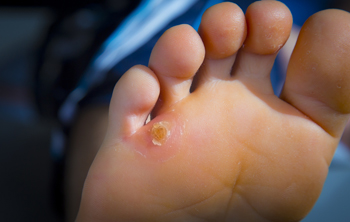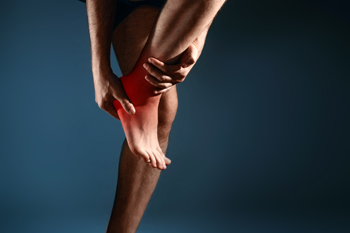Items filtered by date: October 2024
Podiatric Care for Pinky Toe Corns

Corns on the pinky toe are thickened areas of skin that form in response to pressure or friction. They often develop on the outer side of the pinky toe due to constant rubbing against tight or ill-fitting shoes. Corns can be hard or soft, with hard corns typically forming on the bony areas, and soft corns appearing between toes where moisture is present. Symptoms include a hardened, raised bump that can be painful when pressed, redness, and irritation. The pain can intensify with continued friction, making walking uncomfortable. To prevent corns, wear properly fitting shoes with a wide toe box and cushioned insoles. Regularly moisturizing and using a pumice stone on your feet can also help keep the skin soft. If you have a painful or infected corn on any toe, it is suggested that you visit a podiatrist who can provide care, which might include shaving or safely removing the corn.
If you have any concerns regarding your feet and ankles, contact Jim Maxka, DPM of South Penn Foot & Ankle Associates. Our doctor will treat your foot and ankle needs.
Corns: What Are They? and How Do You Get Rid of Them?
Corns can be described as areas of the skin that have thickened to the point of becoming painful or irritating. They are often layers and layers of the skin that have become dry and rough, and are normally smaller than calluses.
Ways to Prevent Corns
There are many ways to get rid of painful corns such as wearing:
- Well-fitting socks
- Comfortable shoes that are not tight around your foot
- Shoes that offer support
Treating Corns
Treatment of corns involves removing the dead skin that has built up in the specific area of the foot. Consult with Our doctor to determine the best treatment option for your case of corns.
If you have any questions please feel free to contact our office located in Hanover, PA . We offer the newest diagnostic and treatment technologies for all your foot and ankle needs.
Common Diabetic Foot Problems

Foot problems in diabetic patients are a leading cause of lower extremity amputations, often resulting from poor circulation and nerve damage, or neuropathy. Diabetes can reduce sensation in the feet, making it difficult to notice injuries like cuts, blisters, or ulcers. These minor injuries can easily become infected, and due to poor healing capacity, infections may worsen and lead to more severe symptoms, if not treated promptly. Regular foot screenings are essential for diabetic patients and education plays a critical role in diabetic foot care. If you have diabetes, it is strongly suggested that you have your feet checked by a podiatrist regularly for early detection of potential complications.
Diabetic foot care is important in preventing foot ailments such as ulcers. If you are suffering from diabetes or have any other concerns about your feet, contact Jim Maxka, DPM from South Penn Foot & Ankle Associates. Our doctor can provide the care you need to keep you pain-free and on your feet.
Diabetic Foot Care
Diabetes affects millions of people every year. The condition can damage blood vessels in many parts of the body, especially the feet. Because of this, taking care of your feet is essential if you have diabetes, and having a podiatrist help monitor your foot health is highly recommended.
The Importance of Caring for Your Feet
- Routinely inspect your feet for bruises or sores.
- Wear socks that fit your feet comfortably.
- Wear comfortable shoes that provide adequate support.
Patients with diabetes should have their doctor monitor their blood levels, as blood sugar levels play such a huge role in diabetic care. Monitoring these levels on a regular basis is highly advised.
It is always best to inform your healthcare professional of any concerns you may have regarding your feet, especially for diabetic patients. Early treatment and routine foot examinations are keys to maintaining proper health, especially because severe complications can arise if proper treatment is not applied.
If you have any questions please feel free to contact our office located in Hanover, PA . We offer the newest diagnostic and treatment technologies for all your foot and ankle needs.
Various Causes of Heel Pain

Heel pain is a common problem that can arise from various conditions. One frequent cause is plantar fasciitis, which involves inflammation of the thick tissue band along the bottom of the foot, leading to sharp pain near the heel. Bursitis, another issue, occurs when the fluid-filled sacs cushioning the heel become inflamed, often due to repetitive stress. Heel spurs are bony growths on the underside of the heel, and they can form from long-term strain on the foot's muscles and ligaments. Additionally, a pump bump is a bony enlargement at the back of the heel caused by pressure from shoes. Achilles tendonitis, characterized by inflammation of the Achilles tendon, usually results from overuse or tight calf muscles. To diagnose heel pain, a healthcare provider will typically conduct a physical exam, review your medical history, and recommend imaging tests like X-rays or MRIs. Treatment options often include rest, stretching exercises, orthotic devices, and anti-inflammatory medications. If you experience persistent heel pain, it is suggested you make an appointment with a podiatrist for an accurate diagnosis and tailored treatment plan.
Many people suffer from bouts of heel pain. For more information, contact Jim Maxka, DPM of South Penn Foot & Ankle Associates. Our doctor can provide the care you need to keep you pain-free and on your feet.
Causes of Heel Pain
Heel pain is often associated with plantar fasciitis. The plantar fascia is a band of tissues that extends along the bottom of the foot. A rip or tear in this ligament can cause inflammation of the tissue.
Achilles tendonitis is another cause of heel pain. Inflammation of the Achilles tendon will cause pain from fractures and muscle tearing. Lack of flexibility is also another symptom.
Heel spurs are another cause of pain. When the tissues of the plantar fascia undergo a great deal of stress, it can lead to ligament separation from the heel bone, causing heel spurs.
Why Might Heel Pain Occur?
- Wearing ill-fitting shoes
- Wearing non-supportive shoes
- Weight change
- Excessive running
Treatments
Heel pain should be treated as soon as possible for immediate results. Keeping your feet in a stress-free environment will help. If you suffer from Achilles tendonitis or plantar fasciitis, applying ice will reduce the swelling. Stretching before an exercise like running will help the muscles. Using all these tips will help make heel pain a condition of the past.
If you have any questions please contact our office located in Hanover, PA . We offer the newest diagnostic and treatment technologies for all your foot and ankle needs.
Plantar Warts Can Be Treated!
Bad Habits for Your Feet

Your feet endure a lot, but certain habits can damage them over time. For starters, wearing high heels or shoes that are too tight can lead to a host of issues, like bunions, corns, and even chronic pain. High heels, while stylish, alter your gait and put extra pressure on the toes and balls of your feet. To avoid these problems, opt for well-fitting shoes with ample room in the toe box and supportive soles. Additionally, do not overlook the impact of flip-flops. While they might be a go-to for the beach, they offer little support and can contribute to issues like plantar fasciitis and arch pain. Do not forget about socks. They are not just for warmth. Wearing socks helps prevent friction and blisters, keeping your feet more comfortable throughout the day. Finally, remember to replace worn-out shoes. As shoes age, their support diminishes, which can lead to foot pain and alignment issues. If you are experiencing foot pain, it is suggested you schedule an appointment with a podiatrist for personalized advice and solutions for healthier, happier feet.
Finding a properly-fitting shoe is important in reducing injuries and preventing foot problems. For more information about treatment, contact Jim Maxka, DPM from South Penn Foot & Ankle Associates. Our doctor will treat your foot and ankle needs.
Proper Shoe Fitting
A common concern when it comes to foot health, having properly fitted shoes can help prevent injuries to the foot. Out feet affect our posture and gait, which in turn affects the biomechanics and overall bodily structure. With 33 joints, 26 bones, and over 100 ligaments, the potential for serious injury is much greater than one realizes. Although the feet cease growth in adulthood, they still change shape as they mature. Here are some factors to consider when it comes to investing in proper fitting shoes:
- Be sure the shoes fit correctly right away
- Ensure the ball of your foot fits comfortably in the widest portion of the shoes
- Even though they may look fashionable, improper fitting shoes can either create adverse conditions or exacerbate existing ones you may already have
- Walk along a carpeted surface to ensure the shoes comfortably fit during normal activity
Keeping in mind how shoes fit the biomechanics of your body, properly-fitting shoes are vitally important. Fortunately, it is not difficult to acquire footwear that fits correctly. Be sure to wear shoes that support the overall structure of your body. Do your feet a favor and invest in several pairs of well-fitted shoes today.
If you have any questions please feel free to contact our office located in Hanover, PA . We offer the newest diagnostic and treatment technologies for all your foot and ankle needs.
How Running Surfaces Affect the Feet

Different running surfaces affect your feet in distinct ways, and understanding these differences can help prevent injuries. Running on concrete, a common surface, is challenging for the feet due to its hardness, which leads to more stress on the joints. Asphalt is a bit more forgiving but still causes significant impact. Dirt trails provide a softer experience, but uneven terrain increases the risk of falls or ankle injuries. Sand strengthens muscles but also can strain the ankles, while grass is gentler on joints but is often uneven. Tracks and treadmills offer cushioned, consistent surfaces, which reduce stress but may lack variety. Runners can benefit from alternating between these surfaces to avoid overuse injuries and improve overall foot health. A podiatrist can help evaluate foot pain caused by running and recommend strategies to avoid injury. If you are a runner who has foot pain, it is suggested that you schedule an appointment with a podiatrist for a diagnosis and treatment.
All runners should take extra precaution when trying to avoid injury. If you have any concerns about your feet, contact Jim Maxka, DPM of South Penn Foot & Ankle Associates. Our doctor will treat your foot and ankle needs.
How to Prevent Running Injuries
There are a lot of mistakes a runner can make prior to a workout that can induce injury. A lot of athletes tend to overstretch before running, instead of saving those workouts for a post-run routine. Deep lunges and hand-to-toe hamstring pulls should be performed after a workout instead of during a warmup. Another common mistake is jumping into an intense routine before your body is physically prepared for it. You should try to ease your way into long-distance running instead of forcing yourself to rush into it.
More Tips for Preventing Injury
- Incorporate Strength Training into Workouts - This will help improve the body’s overall athleticism
- Improve and Maintain Your Flexibility – Stretching everyday will help improve overall performance
- “Warm Up” Before Running and “Cool Down” Afterward – A warm up of 5-10 minutes helps get rid of lactic acid in the muscles and prevents delayed muscle soreness
- Cross-Training is Crucial
- Wear Proper Running Shoes
- Have a Formal Gait Analysis – Poor biomechanics can easily cause injury
If you have any questions, please feel free to contact our office located in Hanover, PA . We offer the newest diagnostic and treatment technologies for all your foot care needs.

